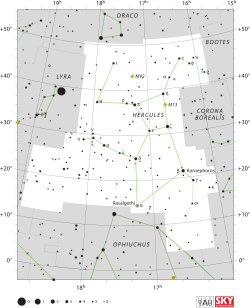45 Herculis
| 45 Herculis | |
 | |
| Observationsdata Epok: J2000.0 | |
|---|---|
| Stjärnbild | Herkules |
| Rektascension | 16t 47m 46,41942s[1] |
| Deklination | +05° 14′ 48,2789″[2] |
| Skenbar magnitud () | +5,22[3], +5,21 – 5,27(V)[4] |
| Stjärntyp | |
| Spektraltyp | A1 Vp Si[5] eller B9p Cr[6] |
| U–B | +0,005[7] |
| B–V | -0,025[7] |
| Variabeltyp | Roterande variabel av Alfa2 Canum Venaticorum-typ (ACV)[4][8] |
| Astrometri | |
| Radialhastighet () | -16,1 ± 2[9] km/s |
| Egenrörelse (µ) | RA: -18,802 ± 0,343[1] mas/år Dek.: -38,735 ± 0,388[1] mas/år |
| Parallax () | 8,1955 ± 0,2169[1] |
| Avstånd | 400 ± 10 lå (122 ± 3 pc) |
| Absolut magnitud () | -0,18[10] |
| Detaljer | |
| Massa | 2,85 ± 0,11[11] M☉ |
| Radie | 4,86[12] R☉ |
| Luminositet | 120,06 ± 20,5[10] L☉ |
| Temperatur | 9 333[13] K |
| Metallicitet | 0,10[13] dex |
| Vinkelhastighet | 44[14] km/s |
| Andra beteckningar | |
| IRAS 16452+0520[15], SAO 121865[15], 2MASS J16474641+0514482[15], GSC 00392-02704[15], HD 151525[15], HIP 82216[15], HR 6234[15], BD+05 3272[15], l Her[16], PLX 3819[15], CCDM J16478+0515A[15], FK5 3333[15], GC 22605[15], GCRV 9659[15], HIC 82216[15], IDS 16428+0526 A[15], N30 3750[15], NSV 7970[15], PPM 163126[15], ROT 2382[15], TD1 19539[15], TYC 392-2704-1[15], UBV 14225[15], V776 Her[15], YZ 5 7496[15], PLX 3819.00[15], WDS J16478+0515A[15], WEB 13882[15], Gaia DR2 4434820128469285248[15], 45 Her, TIC 270917741[15], Gaia DR3 4434820128469285248[15], AG+05 2186[15], UBV M 21682[15] och Renson 42850[15] [17] | |
45 Herculis, som är stjärnans Flamsteed-beteckning, är en ensam stjärna[18] i den sydvästra delen av stjärnbilden Herkules,[10] som också har Bayer-beteckningen l Herculis och variabelbeteckningen V776 Herculis. Den har en genomsnittlig skenbar magnitud på ca 5,22[3] och är svagt synlig för blotta ögat där ljusföroreningar ej förekommer. Baserat på parallaxmätning inom Hipparcosuppdraget på ca 8,2[1] mas, beräknas den befinna sig på ett avstånd på ca 400 ljusår (ca 122 parsek) från solen. Den rör sig närmare solen med en heliocentrisk radialhastighet på ca -16 km/s.[9]
Egenskaper
[redigera | redigera wikitext]45 Herculis är en blå till vit stjärna i huvudserien av spektralklass B9p Cr.[6] Abt och Morrell (1995) klassade den som A1 Vp Si,[5] men båda förslagen anger att den är en kemiskt speciell stjärna av B- eller tidig A-typ, eller Ap-stjärna, med överskott av krom eller kisel. Den har en massa som är ca 2,9[11] solmassor, en radie som är ca 4,9[12] solradier och utsänder ca 120[10] gånger mera energi än solen från dess fotosfär vid en effektiv temperatur på ca 9 300 K.[1]
45 Herculis är en roterande variabel av Alfa2 Canum Venaticorum-typ (ACV),[4] som varierar mellan visuell magnitud +5,21 och 5,27 med en period av 2,05829 dygn.[4]
Se även
[redigera | redigera wikitext]Referenser
[redigera | redigera wikitext]- Den här artikeln är helt eller delvis baserad på material från engelskspråkiga Wikipedia, 45 Herculis, 14 januari 2020.
Noter
[redigera | redigera wikitext]- ^ [a b c d e f] Brown, A. G. A.; et al. (Gaia collaboration) (August 2018). "Gaia Data Release 2: Summary of the contents and survey properties". Astronomy & Astrophysics. 616. A1. arXiv:1804.09365. Bibcode:2018A&A...616A...1G. doi:10.1051/0004-6361/201833051. Gaia DR2 record for this source at VizieR.
- ^ ”Basic data: V* l Her – Variable Star of alpha2 CVn type” (på engelska). Centre de Données astronomiques de Strasbourg. http://simbad.u-strasbg.fr/simbad/sim-basic?Ident=45+Her&submit=SIMBAD+search. Läst 29 augusti 2019.
- ^ [a b] Ducati, J. R. (2002). "VizieR Online Data Catalog: Catalogue of Stellar Photometry in Johnson's 11-color system". CDS/ADC Collection of Electronic Catalogues. 2237. Bibcode:2002yCat.2237....0D.
- ^ [a b c d] ”V776 Her” (på engelska). The International Variable Star Index. AAVSO – American Association of Variable Star Observers. http://www.aavso.org/vsx/index.php?view=detail.top&oid=15587. Läst 29 augusti 2019.
- ^ [a b] Abt, Helmut A.; Morrell, Nidia I. (1995). "The Relation between Rotational Velocities and Spectral Peculiarities among A-Type Stars". Astrophysical Journal Supplement. 99: 135. Bibcode:1995ApJS...99..135A. doi:10.1086/192182.
- ^ [a b] Cowley, A.; et al. (April 1969). "A study of the bright A stars. I. A catalogue of spectral classifications". Astronomical Journal. 74: 375–406. Bibcode:1969AJ.....74..375C. doi:10.1086/110819.
- ^ [a b] Mermilliod, J.-C. (1986). "Compilation of Eggen's UBV data, transformed to UBV (unpublished)". Catalogue of Eggen's Ubv Data. Bibcode:1986EgUBV........0M.
- ^ Samus, N. N.; et al. (2017). "General Catalogue of Variable Stars". Astronomy Reports. 5.1. 61 (1): 80–88. Bibcode:2017ARep...61...80S. doi:10.1134/S1063772917010085.
- ^ [a b] Wilson, Ralph Elmer (1953). "General catalogue of stellar radial velocities". Carnegie Institute Washington D.C. Publication. Bibcode:1953GCRV..C......0W.
- ^ [a b c d] Anderson, E.; Francis, Ch. (2012). "XHIP: An extended hipparcos compilation". Astronomy Letters. 38 (5): 331. arXiv:1108.4971. Bibcode:2012AstL...38..331A. doi:10.1134/S1063773712050015.
- ^ [a b] Netopil, Martin; Paunzen, Ernst; Huemmerich, Stefan; Bernhard, Klaus (July 2017). "An Investigation of the Rotational Properties of Magnetic Chemically Peculiar Stars". Monthly Notices of the Royal Astronomical Society. 468 (3): 2745–2756. arXiv:1703.05218. Bibcode:2017MNRAS.468.2745N. doi:10.1093/mnras/stx674.
- ^ [a b] Shulyak, D.; et al. (2014). "Interferometry of chemically peculiar stars: Theoretical predictions versus modern observing facilities". Monthly Notices of the Royal Astronomical Society. 443 (2): 1629. arXiv:1406.6093. Bibcode:2014MNRAS.443.1629S. doi:10.1093/mnras/stu1259.
- ^ [a b] Wolff, Sidney Carne (October 1967). "A Spectroscopic and Photometric Study of the AP Stars". Astrophysical Journal Supplement. 15: 21. Bibcode:1967ApJS...15...21W. doi:10.1086/190162.
- ^ Royer, F.; et al. (October 2002). "Rotational velocities of A-type stars in the northern hemisphere. II. Measurement of v sin i". Astronomy and Astrophysics. 393: 897–911. arXiv:astro-ph/0205255. Bibcode:2002A&A...393..897R. doi:10.1051/0004-6361:20020943.
- ^ [a b c d e f g h i j k l m n o p q r s t u v w x y z aa ab ac ad ae af ag] SIMBAD Astronomical Database.[källa från Wikidata]
- ^ hämtat från: engelskspråkiga Wikipedia.[källa från Wikidata]
- ^ "45 Her". SIMBAD. Centre de données astronomiques de Strasbourg. Hämtad 2019-06-14.
- ^ Eggleton, P. P.; Tokovinin, A. A. (September 2008). "A catalogue of multiplicity among bright stellar systems". Monthly Notices of the Royal Astronomical Society. 389 (2): 869–879. arXiv:0806.2878. Bibcode:2008MNRAS.389..869E. doi:10.1111/j.1365-2966.2008.13596.x.





